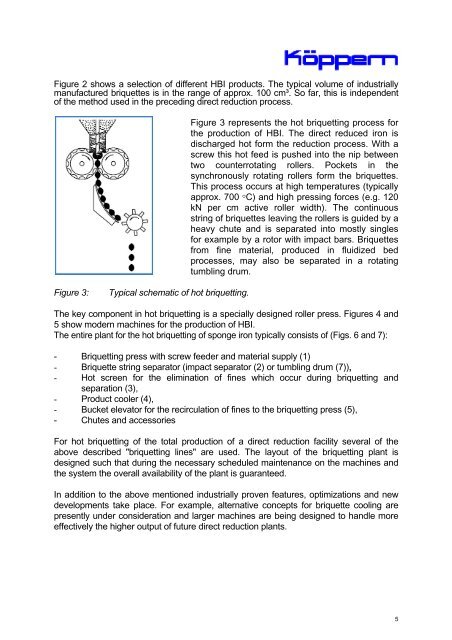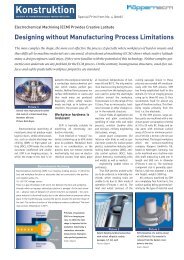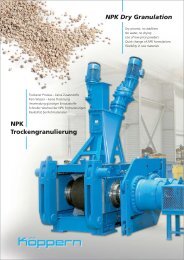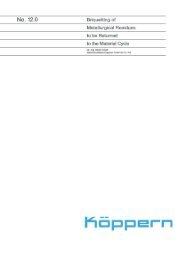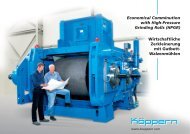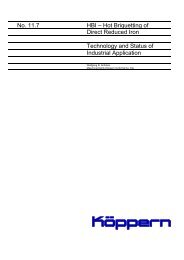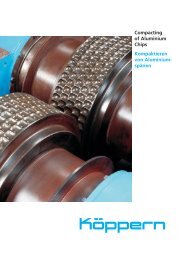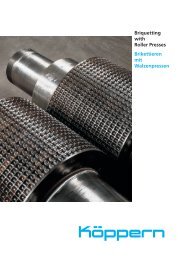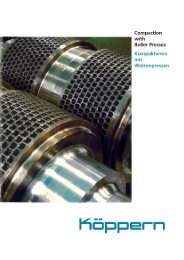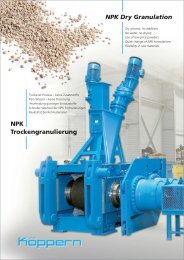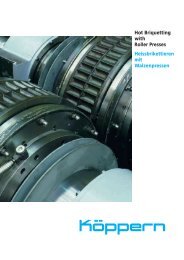Hot Briquetting of - Maschinenfabrik Köppern GmbH & Co. KG
Hot Briquetting of - Maschinenfabrik Köppern GmbH & Co. KG
Hot Briquetting of - Maschinenfabrik Köppern GmbH & Co. KG
Create successful ePaper yourself
Turn your PDF publications into a flip-book with our unique Google optimized e-Paper software.
Figure 2 shows a selection <strong>of</strong> different HBI products. The typical volume <strong>of</strong> industrially<br />
manufactured briquettes is in the range <strong>of</strong> approx. 100 cm³. So far, this is independent<br />
<strong>of</strong> the method used in the preceding direct reduction process.<br />
Figure 3: Typical schematic <strong>of</strong> hot briquetting.<br />
Figure 3 represents the hot briquetting process for<br />
the production <strong>of</strong> HBI. The direct reduced iron is<br />
discharged hot form the reduction process. With a<br />
screw this hot feed is pushed into the nip between<br />
two counterrotating rollers. Pockets in the<br />
synchronously rotating rollers form the briquettes.<br />
This process occurs at high temperatures (typically<br />
approx. 700 °C) and high pressing forces (e.g. 120<br />
kN per cm active roller width). The continuous<br />
string <strong>of</strong> briquettes leaving the rollers is guided by a<br />
heavy chute and is separated into mostly singles<br />
for example by a rotor with impact bars. Briquettes<br />
from fine material, produced in fluidized bed<br />
processes, may also be separated in a rotating<br />
tumbling drum.<br />
The key component in hot briquetting is a specially designed roller press. Figures 4 and<br />
5 show modern machines for the production <strong>of</strong> HBI.<br />
The entire plant for the hot briquetting <strong>of</strong> sponge iron typically consists <strong>of</strong> (Figs. 6 and 7):<br />
- <strong>Briquetting</strong> press with screw feeder and material supply (1)<br />
- Briquette string separator (impact separator (2) or tumbling drum (7)),<br />
- <strong>Hot</strong> screen for the elimination <strong>of</strong> fines which occur during briquetting and<br />
separation (3),<br />
- Product cooler (4),<br />
- Bucket elevator for the recirculation <strong>of</strong> fines to the briquetting press (5),<br />
- Chutes and accessories<br />
For hot briquetting <strong>of</strong> the total production <strong>of</strong> a direct reduction facility several <strong>of</strong> the<br />
above described "briquetting lines" are used. The layout <strong>of</strong> the briquetting plant is<br />
designed such that during the necessary scheduled maintenance on the machines and<br />
the system the overall availability <strong>of</strong> the plant is guaranteed.<br />
In addition to the above mentioned industrially proven features, optimizations and new<br />
developments take place. For example, alternative concepts for briquette cooling are<br />
presently under consideration and larger machines are being designed to handle more<br />
effectively the higher output <strong>of</strong> future direct reduction plants.<br />
5


